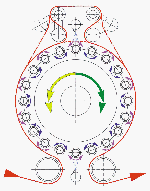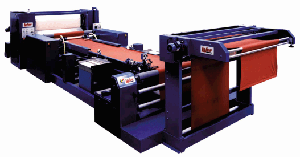
 Each year, Mount Vernons Consumer Products Division consisting of the Johnston, McCormick
Each year, Mount Vernons Consumer Products Division consisting of the Johnston, McCormickand Arkwright plants ships 10 million packages of infant bedding products throughout America. Crib
blankets, sheets, bumpers, comforters, ruffles, towels and receiving blankets are sold under the
most popular names in the business Carter, Babycare, Martha Stewart, Riegel, Honors and Sesame
Street.Our customers place special priority in at least four areas safety, design, delivery and
partnerships, said John Graham, vice president, marketing, Consumer Products Division. To be the
vendor of choice, we must know our customer, their particular profile and what they are saying, in
order to earn and keep their business. We do this through continual customer-driven ideas and
needs.As a vertical producer, Mount Vernon controls all aspects of fabric manufacturing, from the
original bale of cotton or synthetic fiber through the finished, packaged product. Knowing the
exact end use of each baby product is a big advantage as far as engineering the fabric to fit the
products end application, said Graham.Controlling the recipe by testing and knowing fiber length,
strength, color and uniformity results in the ultimate comfort, appearance and long life, according
to the company. In Mount Vernons fabrication facilities, 650 associates employ the latest
technology to cut, sew, finish and package superior quality products for the babys bedroom. Meeting
safety demands is a priority for Mount Vernon. The companys staff of designers creates customized
designs, utilizing a variety of in-house CAD capabilities. Moving fast in design often gives our
customers the competitive edge, continued Graham. Our aim is to make the product better, not
cheaper.Innovation At Johnston
 In 1991, K-Mart came to Mount Vernon requesting individual store order fulfillment. This
In 1991, K-Mart came to Mount Vernon requesting individual store order fulfillment. Thismeant handling orders by store, by product and by replenishment. After extensive investigation,
Mount Vernon partnered with Pinnacle Automation and developed, designed, manufactured and installed
its Direct Store Replenishing System (DSRS).The DSRS consists of three zones that cover an area of
90,000 square feet. The first zone, Rear Storage, is the area designed to maintain the inventory of
Mount Vernon products that move out of the manufacturing (fabrication-cutting, sewing, finishing)
area onto racks. The next area, the Forward Pick zone, is where the individual store order is made
up. A system of lights directs one operator to select every item in the order by correct quantity,
color and size. At this stage, the system also has the ability to automatically replenish the
product inventory before it ever runs out of stock. The operator places the ordered items in
bar-coded totes on an automated conveyor where they move onto the Customization and Packing zone.
Here, packing and assembly of the total order is completed and the cases are routed to the
appropriate shipping doors or temporary storage. Depending on customers requirements, orders are
shipped within 48 to 72 hours from receipt of order.In addition to the obvious savings in handling
and distribution costs, the DSRS allows stores to order smaller quantities than standard case
packs. The system also handles pre-pricing and calculates order size into cubic feet and weight,
which reduces customers shipping costs and corrugated disposal responsibilities.Jim Spinner,
president of this growing division, sums up whats behind this success: Its partnering, partnering.
More and more we are working from the consumer back, not from technology forward. Thats what
motivates us.The Investment Continues
 In
In1999, the Arkwright plant was brought into the Consumer Products Division, which enhanced the
consistency of fabric quality for Johnstons basic raw material. Being able to monitor and control
every phase, from bale opening through the finished, packaged product, gives our baby products,
napery products and institutional products customers a major advantage, said Spinner. Deficiencies
and inconsistencies in quality of service can occur anywhere in the long road from cotton bale to
delivery in the store. With our vertical capabilities, we eliminate or greatly reduce the risk of
not maintaining purity in our quality.Arkwright introduces a whole new set of customer benefits.
The plant is a single floor, flow-through, total system environment bale opening through rotor
spinning, warping, slashing, weaving, napping and pad dyeing. Technical and key staff have operated
the facilities for many years, and they know the business from start to finish. And now with Mount
Vernons company commitment to continuous capital improvement, they have the best of everything to
produce the best product ever, continued Spinner.A modernization and improvement program was put
into place immediately after the facility was acquired. Today, a total of 140 Picanol rapiers and
Sulzer projectiles turn out 100-percent cotton and 100-percent acrylic fabrics in widths ranging
from 153 inches on projectiles and 190, 220 and 240 inches on rapiers. According to Spinner,
automated sizing capabilities are currently being added to further control warp preparation
quality.
May 2000

 Don
Don The next
The next The final
The final It is
It is One of the plants largest undertakings was the 1996 addition of an Eastman die-cutting
One of the plants largest undertakings was the 1996 addition of an Eastman die-cutting Many
Many

 Jackie
Jackie The plant
The plant La
La


